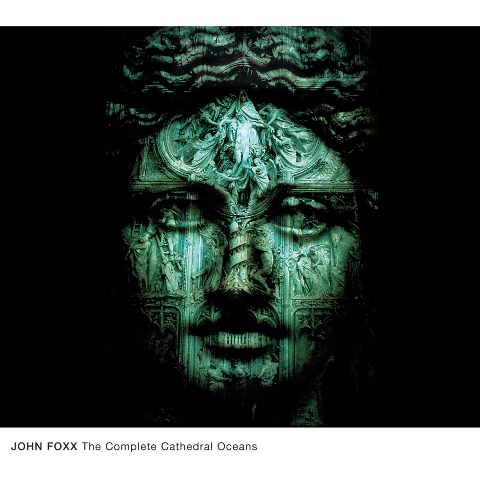Reissue CDs Weekly: John Foxx | reviews, news & interviews
Reissue CDs Weekly: John Foxx
Reissue CDs Weekly: John Foxx
Lavish package devoted to the three ‘Cathedral Oceans’ albums

In 1985, John Foxx released In Mysterious Ways: his fourth solo album since leaving Ultravox in 1979. In 1980, he had charted with “Underpass”, his first solo single. Subsequently, he charted a path where frosty, anomie-filled electropop gave way to the warmth of “Europe After the Rain” and the Beatles-inspired psychedelia of “Endlessly”. The 1983 album The Golden Section was his most straightforwardly poppy to date.
In 1997, he re-emerged with two albums, Cathedral Oceans and Shifting City (made with Louis Gordon). From this point, there was a steady flow of releases. Amongst them were Cathedral Oceans II (2003: issued as the second disc to a reissue of Cathedral Oceans) and Cathedral Oceans III (2005), both follow-up albums to that return. Cathedral Oceans was also revisited as the soundtrack to a DVD in 2003. For each, Foxx had composed what was described in 1997 as “music for a vast, half-submerged ruined cathedral.”
 The Complete Cathedral Oceans collects the three albums and, for the first time, issues them on vinyl. This new package arrives swiftly after the reissue of the three Foxx-era Ultravox albums, a period he recently discussed with theartsdesk. The renewed interest in his always fascinating, often superb back catalogue is welcome. With Cathedral Oceans, spreading what was originally released only on CD across records means each album takes up three sides: Cathedral Oceans is sides A, B and C, and so on. The resultant five-album package is lavish: plain sleeves for each album are bound into a casebound package with a colour book including his striking illustrations.and text drawn from Foxx’s Quiet Man writings (another aspect of his creative life he revisits: as a song, “Quiet Men” was recorded by Ultravox in 1978). A print is also included. The mastering has a greater dynamic range than the original CDs, especially so on Cathedral Oceans II – proof that digital recordings can sound better on vinyl than CD.
The Complete Cathedral Oceans collects the three albums and, for the first time, issues them on vinyl. This new package arrives swiftly after the reissue of the three Foxx-era Ultravox albums, a period he recently discussed with theartsdesk. The renewed interest in his always fascinating, often superb back catalogue is welcome. With Cathedral Oceans, spreading what was originally released only on CD across records means each album takes up three sides: Cathedral Oceans is sides A, B and C, and so on. The resultant five-album package is lavish: plain sleeves for each album are bound into a casebound package with a colour book including his striking illustrations.and text drawn from Foxx’s Quiet Man writings (another aspect of his creative life he revisits: as a song, “Quiet Men” was recorded by Ultravox in 1978). A print is also included. The mastering has a greater dynamic range than the original CDs, especially so on Cathedral Oceans II – proof that digital recordings can sound better on vinyl than CD.
While the music itself is consistent and really does sound as though it has bubbled up from the bottom of an ocean, The Complete Cathedral Oceans tracks changes in Foxx's working methods. Clearly, he was composing with the length of a CD in mind for each album. For Cathedral Oceans, three of the pieces have co-writers: five engineers (including Foxx) and three separate studios were used. Eight years later, for Cathedral Oceans II there are no other writers, Louis Gordon was the sole engineer and two studios are credited. Cathedral Oceans III credits Foxx for everything.
Despite the increasing internalisation – a reversion to the one-band band status of 1980 – there are no discernable sonic shifts or compositional disconnects across the three albums or suggestions that his other work has had an influence. The coherence of vision ensured homogeneity.
Taken as a whole, the three Cathedral Oceans albums are, as they are categorised, ambient music. But instead of solely setting a mood, they dominate the environment in which they are heard to such a degree that hearing them is akin to being wrapped in muslin and submerged in body temperature water. Overall, the mood is devotional. As a child, Foxx was a choir boy. Fans will need this fine package, but at £92 it is no casual purchase. It is also limited to 750 numbered copies. Move fast.
Explore topics
Share this article
more New music
 Album: Fred Hersch - Silent, Listening
A 'nocturnal' album - or is it just plain dark?
Album: Fred Hersch - Silent, Listening
A 'nocturnal' album - or is it just plain dark?
 Music Reissues Weekly: Linda Smith - I So Liked Spring, Nothing Else Matters
The reappearance of two obscure - and great - albums by the American musical auteur
Music Reissues Weekly: Linda Smith - I So Liked Spring, Nothing Else Matters
The reappearance of two obscure - and great - albums by the American musical auteur
 The Songs of Joni Mitchell, Roundhouse review - fans (old and new) toast to an icon of our age
A stellar line up of artists reimagine some of Mitchell’s most magnificent works
The Songs of Joni Mitchell, Roundhouse review - fans (old and new) toast to an icon of our age
A stellar line up of artists reimagine some of Mitchell’s most magnificent works
 Album: Taylor Swift - The Tortured Poets Department: The Anthology
Taylor Swift bares her soul with a 31-track double album
Album: Taylor Swift - The Tortured Poets Department: The Anthology
Taylor Swift bares her soul with a 31-track double album
 theartsdesk on Vinyl: Record Store Day Special 2024
Annual edition checking out records exclusively available on this year's Record Store Day
theartsdesk on Vinyl: Record Store Day Special 2024
Annual edition checking out records exclusively available on this year's Record Store Day
 Album: Jonny Drop • Andrew Ashong - The Puzzle Dust
Bottled sunshine from a Brit soul-jazz team-up
Album: Jonny Drop • Andrew Ashong - The Puzzle Dust
Bottled sunshine from a Brit soul-jazz team-up
 Album: Pearl Jam - Dark Matter
Enduring grunge icons return full of energy, arguably their most empowered yet
Album: Pearl Jam - Dark Matter
Enduring grunge icons return full of energy, arguably their most empowered yet
 Album: Paraorchestra with Brett Anderson and Charles Hazlewood - Death Songbook
An uneven voyage into darkness
Album: Paraorchestra with Brett Anderson and Charles Hazlewood - Death Songbook
An uneven voyage into darkness
 theartsdesk on Vinyl 83: Deep Purple, Annie Anxiety, Ghetts, WHAM!, Kaiser Chiefs, Butthole Surfers and more
The most wide-ranging regular record reviews in this galaxy
theartsdesk on Vinyl 83: Deep Purple, Annie Anxiety, Ghetts, WHAM!, Kaiser Chiefs, Butthole Surfers and more
The most wide-ranging regular record reviews in this galaxy
 Album: EMEL - MRA
Tunisian-American singer's latest is fired with feminism and global electro-pop maximalism
Album: EMEL - MRA
Tunisian-American singer's latest is fired with feminism and global electro-pop maximalism
 Music Reissues Weekly: Congo Funk! - Sound Madness from the Shores of the Mighty Congo River
Assiduous exploration of the interconnected musical ecosystems of Brazzaville and Kinshasa
Music Reissues Weekly: Congo Funk! - Sound Madness from the Shores of the Mighty Congo River
Assiduous exploration of the interconnected musical ecosystems of Brazzaville and Kinshasa
 Ellie Goulding, Royal Philharmonic Concert Orchestra, Royal Albert Hall review - a mellow evening of strings and song
Replacing dance beats with orchestral sounds gives the music a whole new feel
Ellie Goulding, Royal Philharmonic Concert Orchestra, Royal Albert Hall review - a mellow evening of strings and song
Replacing dance beats with orchestral sounds gives the music a whole new feel

Add comment